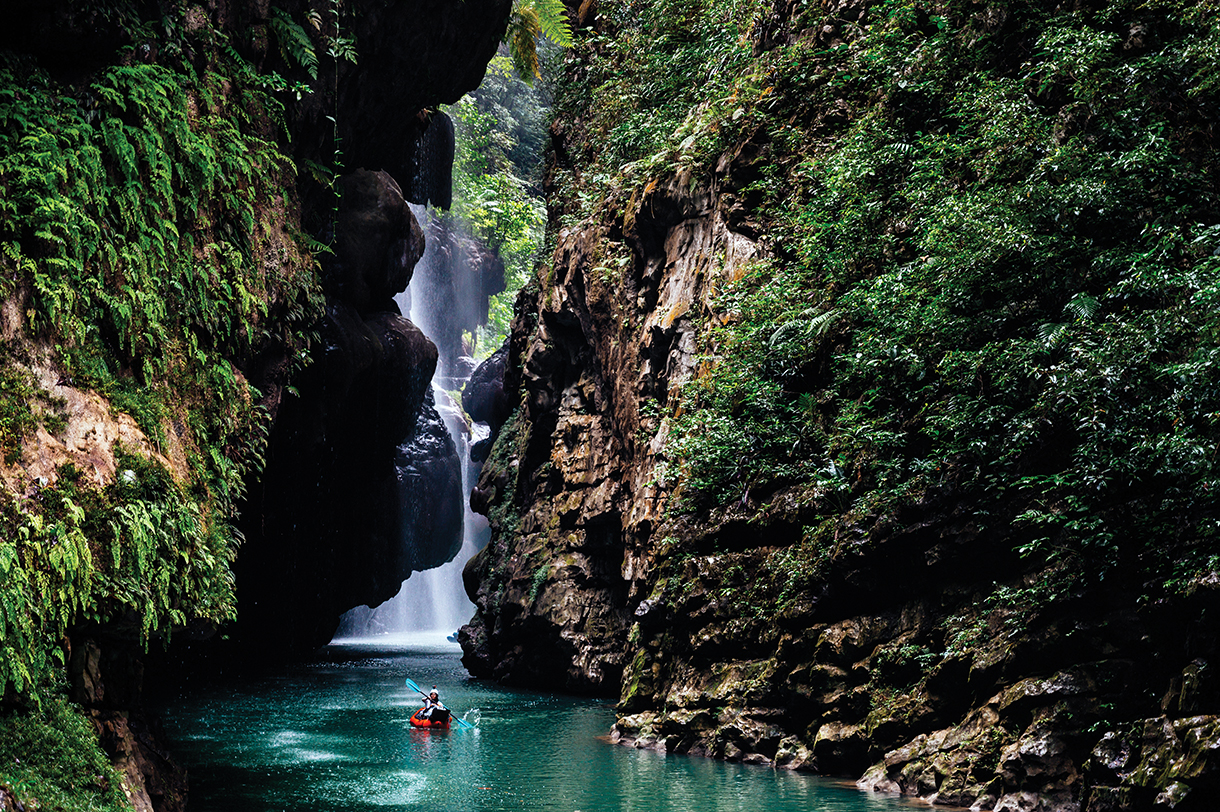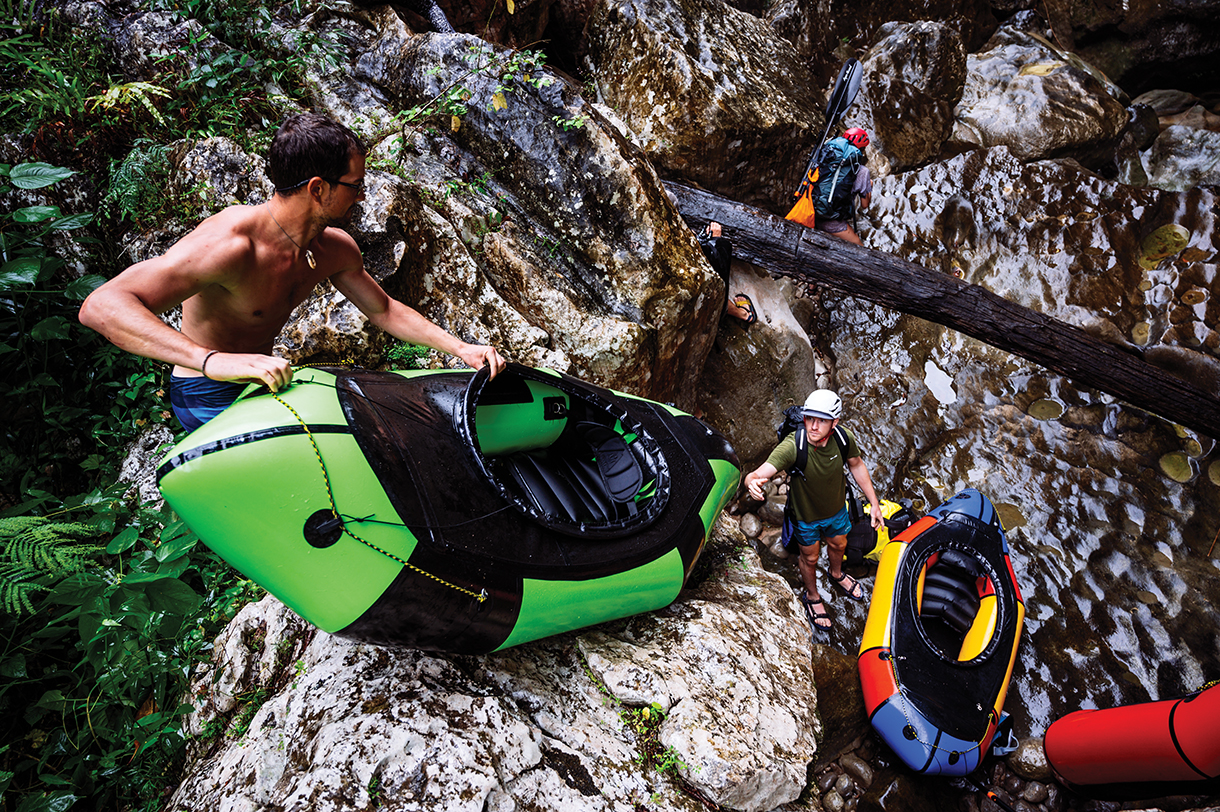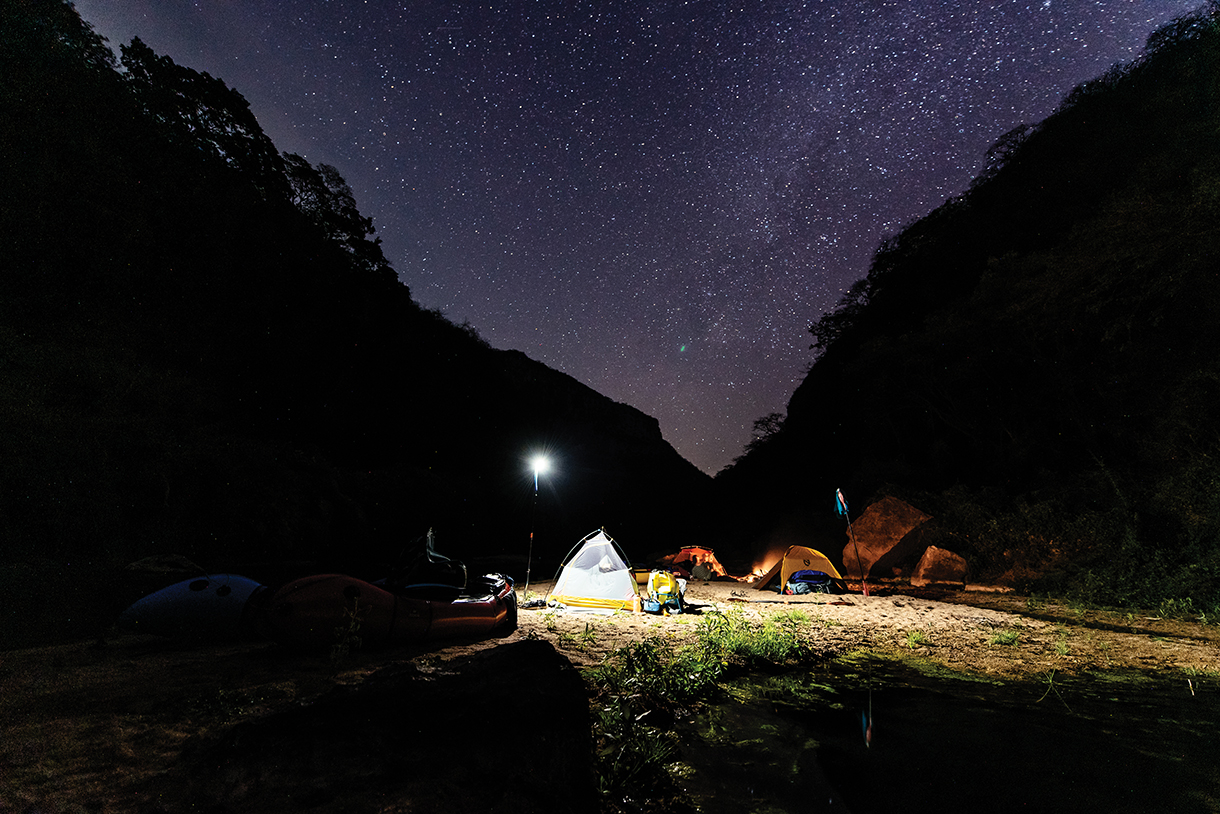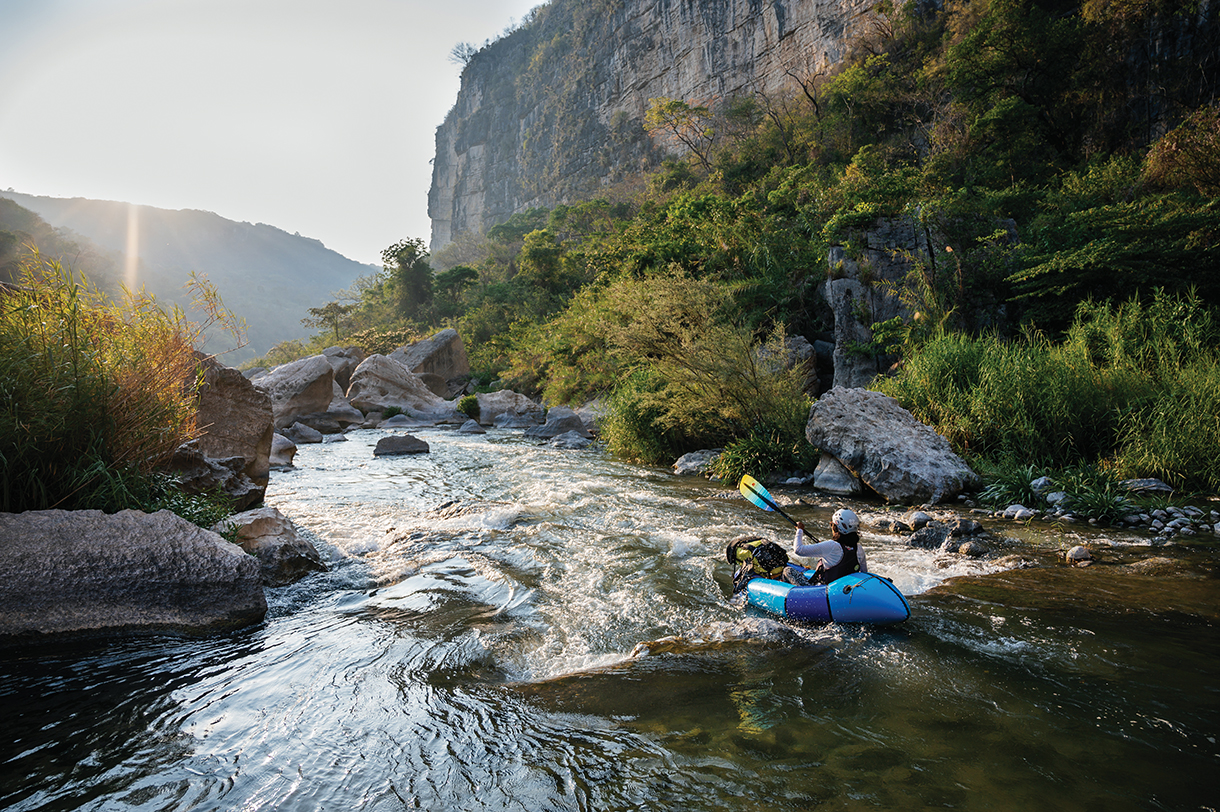
Rapid Obsession
Packrafting Mexico’s hidden Rio La Venta is an adrenaline-pumping adventure through deep canyon walls with thick jungle canopies and many secrets to discover.
Enter the 50-mile natural labyrinth of Mexico’s Rio La Venta on a rafting expedition, and the only way out is a week away.
An almost inaudible roar emits from the canyon; its volume increases with each passing minute. The sound means one of two things: another set of whitewater rapids or a spectacular waterfall. Sitting up in the packraft—an inflatable, one-person whitewater boat—it’s time to ready the paddle in anticipation of what is just around the next bend.
Nestled deep within the Mexican state of Chiapas (closer to Guatemala than Mexico City) and characterized by rainforests dotted with ancient Mayan ruins, the Rio La Venta winds for 50 miles through a narrow canyon with walls taller and steeper than Manhattan’s One World Trade Center. Enter the natural labyrinth on a rafting expedition, and the only way out is a week away.
“Around every bend of the river it feels like you are Indiana Jones traveling back in time,” says independent professional guide Jacob Moon (moonmountainman.com). “Eventually you become so immersed in the adventure that you forget that there is a busy, modern world outside of the narrow biome that you’ve floated into.” What makes Moon’s expedition even more unique from the typical whitewater trips run throughout Mexico and other parts of Central America is the vessel he and his groups use to navigate the river: the small and mighty packraft.

These compact, relatively lightweight inflatable boats allow paddlers the ability to access bodies of water that would normally be too cumbersome to reach with traditional hard-body kayaks; they’re also small enough to pass through sections too tight for full-size rafts. All the while, they are durable enough to handle multiday or -week expeditions and tackle serious whitewater. In short, there’s nothing else like a packraft for paddling the Rio La Venta during its low season in the North American spring.
While local operators run occasional whitewater rafting trips down La Venta during the high-flow rainy season (North American autumn), paddling the river in March, April, or May provides a couple distinct advantages. The first is that the river, which requires a local permit to enter, becomes relatively accessible. Since parties that enter the river must remain committed (due to the imposing nature of the canyon walls), lower river flow means smaller rapids, which makes the entire course doable for even novice paddlers, providing that they have a good degree of fitness. Moon says, “Experienced adventurers who embrace the unknown—and don’t mind leaving behind the comforts of modern life for a week at a time—will feel right at home.” The second advantage is that the lower water level reveals countless sandy beaches, which make for exceptional campsites.
The journey begins in Tuxtla, Mexico, the vibrant capital of the southern state. Here Moon meets the expedition group, stocks up on last-minute supplies, and gets a fix of fresh tacos before heading into the wilderness for an entire week. An hour’s drive leads to the canyon rim; a partial descent by van foreshadows what comes next: a thousand-foot vertical hike down on a switchback formed with concrete steps. The jungle’s canopy is thick, as if guarding La Venta’s secrets. Packs—loaded with a week’s worth of food, camping gear, and packrafting gear—weigh heavily upon hikers’ hips, backs, and shoulders. In less than an hour the path levels out and opens up onto the beach. A glance up and the weight in the pack disappears, along with the air in the lungs. The canyon is stunning.
To the right, the emerald river vanishes around a bend; unfathomably tall walls, striped with streaks of red, orange, yellow, and white, box it in. Upriver to the left the water flows around a series of boulders, which have fallen from hundreds of feet onto the sandy bed during some ancient event. The sun glistens through a 100-foot-tall waterfall. Closer inspection reveals a series of caves, tunnels, and pools behind it, forming a natural waterpark. It’s time to play. The river’s canyon and banks are a wild paradise; and this place is home for the night. After a leisurely breakfast the next morning, camp is broken down; packrafts are inflated; gear is loaded; and the paddling begins.
The Rio La Venta’s gentle current is alive with mystery; a rainbow of jungle hues punctuate the all-enveloping emerald canopy, the shape of which is redefined with every bend. A flock of fluorescent green parrots dance along the canyon rim, their gravity-defying aerial display taking place 1,000 feet above the river. There must be 30 parrots juking through the sky; as quickly as they came, they are gone. What never changes are how ambitiously the vertical walls stretch out toward the heavens. The packrafts provide visual perspective: Tiny, colorful dots serving as a reminder that you are truly small—and committed to drifting the labyrinth for the next week.

The third day blends into the fourth; with each stream and waterfall passed, conditions on the river improve. The first couple of days are challenging while everyone is becoming accustomed to paddling their rafts through tight rapids, but by the middle of the trip, it’s easy to find the groove.
“The river shifts from tranquility to adrenaline-inducing almost perpetually,” says Moon. “The contrast always keeps you engaged and excited to explore what comes next.” When a roar suddenly grows from inaudible to imminent, around the bend a most impressive rapid run beckons. Ample volume makes it navigable; a three-foot drop leads into a pool. From there, a quick right turn leads to another rapid before emptying out to a section of flat water. The plan determined after scouting the rapid, the team will enter from the shore one at a time.
With a visual of the line in the forefront of their minds, paddlers hop into the packrafts, secure the sprayskirt around the coaming of the boat’s deck, and push off the shore. Time to send. The rafts go right in, buck up high, and then get sucked straight through the center of the rapid into an eddy. There’s hardly time to recompose before getting drafted in again. This time, it’s around a tight bend, then a straight drop into the mirror-like stillness ahead.
Lazily, the rafts drift forward, a total contradiction to the previous 30 seconds—then someone from the group explodes into the sky from a blocky, overhanging cliff band 25 feet above the surface of the river. He rotates backward for as long as gravity will be defied; time slows down as he sails over the boat and lands harmlessly in the deep emerald waters to the right.
Moon shores his raft in a small sheltered cove across from the cliff jump. A series of elevated, flat, blocky platforms—just large enough for tents—punctuate the bank. A rock peninsula juts out into the river, creating two small bays, a perfect place to park the boats—and hang out. Looking up rewards with an impressive view of the 1,500-foot canyon wall, its horseshoe shape enveloping the bend on both sides. As the light begins to fade, music from insects, birds, frogs, and bats echoes around and the stars come out. The fire rages and larger-than-life shadow play ensues. It’s juvenile at first, but the stories evolve into entire scripted sections, projected all around. Stories circulate; hours pass. As the leaping flames recede into smoldering coals, so too do the sounds of jubilee.
On the last leg of the trip, hydraulics come more into play, which requires careful navigation, scouting, and spotting. The team tackles a few portages, hiking around sections of the river deemed too technical, voluminous, or debris-riddled to safely paddle through. Although the difficulty of the river has increased, so has paddlers’ confidence and skill level; paddling through sections that may have seemed impossible during the first couple of days are now tackled with relative ease. Unlike whitewater rafting, where each paddler is part of a boat team, packrafting requires individual paddlers to make it down river. But the sport is not practiced alone, as teams help each other out by watching each other and providing assistance.

Past a waterfall, the canyon continues to narrow until it forms a fully enclosed arch. Therein lies the Arco Del Tiempo, an extended archway carved over a period of 80 million years; its ceiling close to 600 feet high. A local adventure guide rappels 45 feet down to the river on a climbing rope and the escape plan becomes clear, as he anchors to a tree at the mouth of the Arco Del Tiempo.
This is the first feasible exit point since put-in; exfiltration from the canyon is achieved by ascending the guide’s rope using a special aid-climbing device called a jumar. Ascenders can slide freely up the rope, but the jumar locks into place to prevent them from sliding back down. “Can this be it?”
The team climbs up one at a time; then hauls the gear, and it’s over. A steep hiking path leads out of the canyon; thick jungle canopy threatens to envelop the well-trodden track. As the terrain flattens, the path widens to accommodate old farm trucks. Reminders of real life, livestock grazes clearings; hounds run alongside the fenced-in plots. Entrance into a small village yields hot, handmade corn tortillas, beans, and queso—along with sweet Mexican Cokes. The aromatic flavors are fleeting, but the impression from the canyon will stay. The city walls will inevitably close in, and the perspective from the packraft will
be there.




